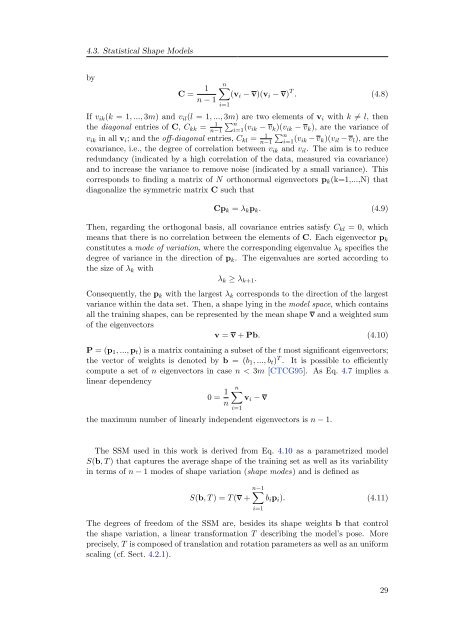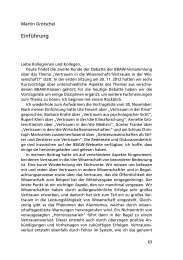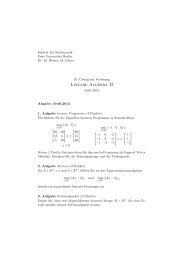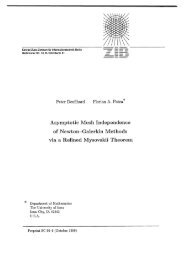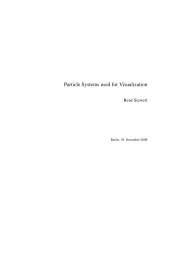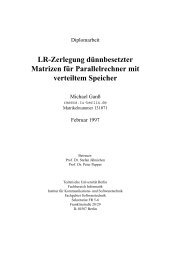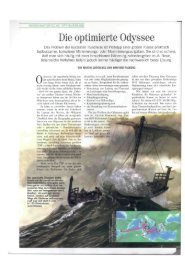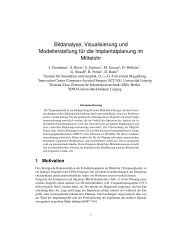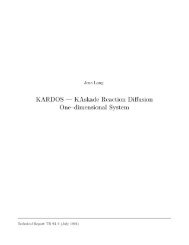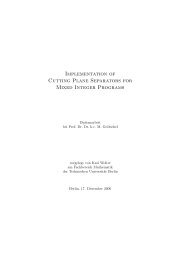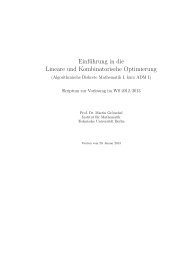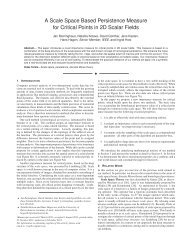3D Reconstruction of the Human Rib Cage from 2D Projection ... - ZIB
3D Reconstruction of the Human Rib Cage from 2D Projection ... - ZIB
3D Reconstruction of the Human Rib Cage from 2D Projection ... - ZIB
You also want an ePaper? Increase the reach of your titles
YUMPU automatically turns print PDFs into web optimized ePapers that Google loves.
4.3. Statistical Shape Models<br />
by<br />
C = 1<br />
n − 1<br />
n<br />
(vi − v)(vi − v) T . (4.8)<br />
i=1<br />
If vik(k = 1, ..., 3m) and vil(l = 1, ..., 3m) are two elements <strong>of</strong> vi with k = l, <strong>the</strong>n<br />
<strong>the</strong> diagonal entries <strong>of</strong> C, Ckk = 1 n n−1 i=1 (vik − vk)(vik − vk), are <strong>the</strong> variance <strong>of</strong><br />
vik in all vi; and <strong>the</strong> <strong>of</strong>f-diagonal entries, Ckl = 1 n n−1 i=1 (vik − vk)(vil − vl), are <strong>the</strong><br />
covariance, i.e., <strong>the</strong> degree <strong>of</strong> correlation between vik and vil. The aim is to reduce<br />
redundancy (indicated by a high correlation <strong>of</strong> <strong>the</strong> data, measured via covariance)<br />
and to increase <strong>the</strong> variance to remove noise (indicated by a small variance). This<br />
corresponds to finding a matrix <strong>of</strong> N orthonormal eigenvectors pk(k=1,...,N) that<br />
diagonalize <strong>the</strong> symmetric matrix C such that<br />
Cpk = λkpk. (4.9)<br />
Then, regarding <strong>the</strong> orthogonal basis, all covariance entries satisfy Ckl = 0, which<br />
means that <strong>the</strong>re is no correlation between <strong>the</strong> elements <strong>of</strong> C. Each eigenvector pk<br />
constitutes a mode <strong>of</strong> variation, where <strong>the</strong> corresponding eigenvalue λk specifies <strong>the</strong><br />
degree <strong>of</strong> variance in <strong>the</strong> direction <strong>of</strong> pk. The eigenvalues are sorted according to<br />
<strong>the</strong> size <strong>of</strong> λk with<br />
λk ≥ λk+1.<br />
Consequently, <strong>the</strong> pk with <strong>the</strong> largest λk corresponds to <strong>the</strong> direction <strong>of</strong> <strong>the</strong> largest<br />
variance within <strong>the</strong> data set. Then, a shape lying in <strong>the</strong> model space, which contains<br />
all <strong>the</strong> training shapes, can be represented by <strong>the</strong> mean shape v and a weighted sum<br />
<strong>of</strong> <strong>the</strong> eigenvectors<br />
v = v + Pb. (4.10)<br />
P = (p1, ..., pt) is a matrix containing a subset <strong>of</strong> <strong>the</strong> t most significant eigenvectors;<br />
<strong>the</strong> vector <strong>of</strong> weights is denoted by b = (b1, ..., bt) T . It is possible to efficiently<br />
compute a set <strong>of</strong> n eigenvectors in case n < 3m [CTCG95]. As Eq. 4.7 implies a<br />
linear dependency<br />
0 = 1<br />
n<br />
vi − v<br />
n<br />
<strong>the</strong> maximum number <strong>of</strong> linearly independent eigenvectors is n − 1.<br />
i=1<br />
The SSM used in this work is derived <strong>from</strong> Eq. 4.10 as a parametrized model<br />
S(b, T ) that captures <strong>the</strong> average shape <strong>of</strong> <strong>the</strong> training set as well as its variability<br />
in terms <strong>of</strong> n − 1 modes <strong>of</strong> shape variation (shape modes) and is defined as<br />
n−1 <br />
S(b, T ) = T (v + bipi). (4.11)<br />
The degrees <strong>of</strong> freedom <strong>of</strong> <strong>the</strong> SSM are, besides its shape weights b that control<br />
<strong>the</strong> shape variation, a linear transformation T describing <strong>the</strong> model’s pose. More<br />
precisely, T is composed <strong>of</strong> translation and rotation parameters as well as an uniform<br />
scaling (cf. Sect. 4.2.1).<br />
i=1<br />
29


